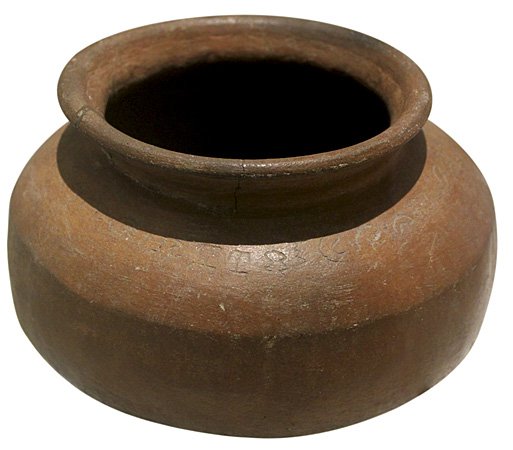Cultural Center of the Philippines
ENCYCLOPEDIA OF
PHILIPPINE ART
[Calatagan Pot Nmp 1961-A-21]
Ca 15th century / Clay / Height 12 cm, body width 20.2 cm, rim diameter 14.8 cm., weight 872 g / Talisay, Calatagan, Batangas Province, southern Luzon, Philippines / NMP 1961-A-21 purchased 1961 / National Museum of the Philippines Collection
The Calatagan Pot, as it is popularly known, is an ellipsoid earthenware container with everted syllabic inscriptions incised along its shoulder. It was discovered in Calatagan, Batangas, and brought to the attention of then National Museum junior archaeologist and site supervisor Alfredo Evangelista when he returned to the site on the weekend. Because of these inscriptions, the museum declared it a National Cultural Treasure sometime after it entered its collections in 1961.
Fifteenth-century Sawankhalok (Thai) and Chinese (Ming Dynasty) trade ceramics were reportedly found in association with the Calatagan Pot. But determining an absolute date for the artifact has proven to be a problem. Hair pomade applied on the pot’s surface when earlier attempts were made to replicate this important piece has resulted in contamination. Archaeologists did not accept the very old carbon 14 dates. The museum also conducted experiments on fired and unfired clay and found that the inscriptions on the Calatagan Pot were incised on the surface before firing.
Scholars have studied these syllabic inscriptions but none have presented their findings with certainty. Juan Francisco, a specialist in Indian scripts and language, has not accepted the authenticity of the pot. On the other hand, Dutch paleographer Johannes de Casparis compared the pot’s inscriptions to those on other artifacts in the National Museum and declared the Calatagan Pot authentic. Moreover, physician and independent scholar of Philippine paleography Quentin Oropilla proposed that the inscriptions were part of a ceremonial prayer of offering that was not Sanskrit-based but Austronesian, a family of languages from which all Central Philippine languages derived, including current Tagalog, Ilocano, and Bisaya. Philippine literature scholar Ramon Guillermo and anthropologist Myfel Paluga proposed a methodology combining paleography and cryptography to decode the inscription. Their findings resulted in a decoded text combining Visayan and Javanese languages and which they posit to signify as a charm or spell. Further scientific analyses are required to determine when and why the Calatagan Pot inscriptions were written and whether it may be conclusively considered an artifact from the Philippine and Southeast Asian prehistoric past.
Written by Purissima Benitez-Johannot, with notes from Cecilia S. Dela Paz
Sources
Guillermo, Ramon, and Myfel Joseph Paluga. “Barang King Banga: Isang Eksperimental na Pagbasang Bisaya sa Inskripsyon sa Banga ng Calatagan.” 2008-09. Social Science Diliman, Vol 5, Nos 1-2, Jan-Dec, 26-82.
Ronquillo, Wilfredo P. 2011a. “Ellipsoid Vessel with Syllabic Inscriptions along the Rim.” In Paths of Origins: The Austronesian Heritage from the National Museum of the Philippines, the Museum Nasional Indonesia, and the Rijksmuseum voor Volkenkunde, edited by Purissima Benitez-Johannot, 126-27. Singapore: ArtPostAsia.
